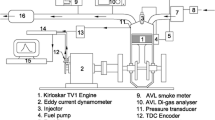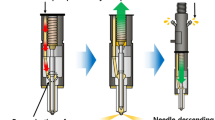Abstract
It has been experimentally established that the modification of the spray nozzle structure of the diesel fuel injector due to the reduction of the length from 18 mm to 10 mm and the diameter from 6 mm to 4 mm of the precision guide, the increase in the diameter of the needle rod to increase its rigidity, the development of the cooling cavity under the differential needle pad increasing the number of fuel supply channels from 3 to 5, increasing the fuel injection pressure from 21–22 MPa to 27–28 MPa and reducing the needle stroke from 0.45 mm to 0.35 mm affects the power and economic parameters of tractor dies spruce. The use of experimental sprayers in a tractor diesel with gas turbine supercharging makes it possible to reduce the specific fuel consumption by 2–6 g/kW h and the temperature of the exhaust gases by 30–50 °C depending on the loading regime, as well as some increases (up to 2%) the coefficient of adaptability for torque. Using sprayers of experimental design in diesel with gas turbine supercharging allows to reduce the specific effective fuel consumption by 2–6 g/kW h and exhaust gas temperature by 30–50 °C depending on the loading mode, also some increase (up to 2%) of the coefficient of adaptability for the torque is registered.
Similar content being viewed by others
Keywords
- Injector
- Precision-guiding interface
- Moment of injection of the fuel
- Velocity and loading characteristics
- Fuel consumption
- Temperature of the exhaust gases
1 Introduction
An analysis of the modern diesel engine manufacturing development shows the tendency of a continuous increase in the technical level of agrimotor diesel engines. The increase of the fuel injection pressure is the tendency of improving the performance of working cycle and the operational properties of transport diesel engines [1,2,3]. In this regard, the most important tasks of modern diesel engineering are the improvement of the fuel equipment elements design, in particular, the fuel injector nozzle, in order to increase fuel economy and the engine operating life, to reduce emissions of harmful substances with exhausted gases [4,5,6].
2 Background to the Assignment of the Study
In autotractor diesel engines, spray nozzles with an elongated body (types DLL and DLLA according to the Bosch classification) are increasingly used [7]. A feature of the design of such nozzles is the remote location of the directional precision fitting from the firing surface of the cylinder head and the reduced diameter of the protruding part of the housing in order to reduce the heat-absorbing surface and increase the service life [5, 8]. Directional precision fitting is an element of the sprayer, which determines the hydraulic density, mobility, and stability of the needle when moving it in the body. Locking precision fitting performs the function of sealing of the sprayer hydraulic path and the high-pressure fuel line. The efficiency and operating life of the injection nozzle’s precision fitting in the diesel are determined by the specific features of the thermal (the temperature of the working gases in the cylinder), the hydrodynamic (fuel pressure), and the mechanical (spring-loaded nozzle) loads that cause run out on the contact surfaces. Experience in the operation of Russian diesel engines indicates that up to 75% of failed sprayers have a loss of hydraulic density due to the premature attainment of extreme run out on the directional and locking precision fitting [9,10,11].
The design of the DLLA-type diffusers has a number of disadvantages. A significant reduction of the body resistance leads to the appearance of cracks and to decrease in the strength of the body, especially in connection with the tendency to further fuel injection pressure increase. Elongation of the needle has a negative effect on its stability and complicates the technology of manufacturing, and also makes it difficult to ensure reliable operation of the locking precision fitting due to possible misalignment of the needle during its movement. In addition, the diameter reduction of the body’s protruding part makes it difficult to accommodate an increased number of sprayer’s atomizing nozzles, which is necessary, for example, when boosting in diesel engines with a volumetric method of mixture formation [12,13,14].
These drawbacks in the design of the elongated sprayer determine the need to improve the design of the DLA-type sprayer (Fig. 1a), which has a much harder body and a relatively short needle. Mechanical, temperature, mounting deformations and increased wear cause misalignment of the needle and hole in the housing and, as a consequence, unstable position of the spray gun needle. Increase in the temperature of the sprayer is accompanied by a reduction in standoff and leakage in the directional precision fitting, which increases injection pressure due to the geometric parameters changes of the needle during thermal expansion. It is obvious that a decrease in the temperature and run out in the directing and locking precision fittings, reduces its thermal mechanical and hydrodynamic loading [15, 16].
3 Design Solution for Changing the Sprayer’s Hydraulic Path
To reduce thermal mechanical and hydrodynamic loading, the authors developed an original design of a DLA-type sprayer with modified needles and body’s hydraulic path. The developed design of the experimental sprayer (Fig. 1b) provides an implementation of the following technical solutions, for the preservation of the overall body dimensions [17, 18]:
-
Reducing the directional precision fitting length from 18 to 10 mm and the diameter from 6 to 4 mm to reduce needle’s weight and remove as far as possible from the firing surface of the cylinder head;
-
Increase the needle bar diameter to maintain its toughness;
-
Development of the cooling cavity under the needle pad for the intensification of heat removal from the needle guide and the nozzle body;
-
Increase the number of fuel supply channels from 3 to 5 to intensify the local cooling of the needle rod and the nozzle body;
-
Reducing the stroke of the needle from 0.45 to 0.35 mm to reduce the friction path in the guide and the dynamic load in the locking fitting;
-
Reducing the contact area of the needle shank with the nozzle rod to reduce the chance of needle misalignment during its movement;
-
Increase in the pressure of the injection of fuel from 21–22 to 27–28 MPa.
The geometric parameters changes of the needle directional precision fitting are accompanied by a decrease in its differential plane. This reduces the spring force of the nozzle when the injection start pressure is increased to 27–28 MPa. Reducing the force of tightening the nozzle spring and the weight of the sprayer’s needle helps to reduce the shock load in the locking precision fitting when the needle is placed on the seat and to reduce run out of the contacting surfaces [19, 20].
The new design of the needle and the body’s hydraulic tract configuration in the experimental sprayer allow to qualitative change in the nature of the outflow of fuel from the spray holes. With an increase in the initial and average fuel injection pressures, the diameter of the droplets decreases, the quality of spraying of the fuel improves with the decay of the jet, providing a more even distribution of the fuel in the combustion chamber space, which provides improved mixture formation. Reducing the stroke of the needle helps to increase the speed of the fuel in the channels of the spray holes, the turbulence of the fuel flow and the fuel jets speed in the combustion chamber.
4 Methodology of Research
The purpose of experimental studies is to determine the effectiveness of improvement the nozzle sprayer design in order to improve the technical and economic indicators of a tractor diesel engine 4ChN15/20.5. Carrying out diesel engine tests on a brake stand (Fig. 2) assumed the sequence of the following stages:
-
Preparation and calibration of the elements of the electric brake stand, measuring and recording equipment;
-
Preparation and adjustment of diesel engine mechanisms and systems 4ChN15/20.5. In accordance with technical requirements 51-DTT during the tests, summer diesel fuel was used according to GOST 305-82 and lubricating oil M10DM with quality indicators according to GOST 8581-78.
-
Regulation of fuel injectors with the test sprayers at the required injection start pressure with visual assessment of the fuel spraying quality on a nonmotorized bench. The fuel injection pressure was set for the regular sprayers—21–22 MPa, and for the experimental ones—27–28 MPa;
-
Installation of fuel injectors on diesel;
-
Run-in (for 2 h) fuel injectors on the working diesel engine;
-
Determination of the diesel engine parameters in accordance to GOST 18508-80, GOST 18509-80, and the technical requirements 51-DTT when operating on an external high-speed and load characteristics (at speeds of 1250 and 900 min−1 crankshaft) with the optimal fuel injection advance angle and standard sprayers;
-
Determination of the diesel engine parameters in accordance to GOST 18508-80, GOST 18509-80 and the technical requirements 51-DTT when working on an adjusting (with changed fuel injection advance angle), and then on an external high-speed and load characteristics (at crankshaft speeds of 1250 and 900 min−1) with an optimal fuel injection advance angle and experimental sprayers.
5 Results of the Study
In order to optimize the fuel injection advance angle (based on the criterion of the minimum specific effective consumption ge of fuel), a control characteristic was determined in a diesel engine equipped with experimental nozzles (Fig. 3). It has been established that at the crankshaft speeds corresponding to the nominal power (n = 1250 min−1) and maximum torque (n = 900 min−1), the optimal fuel injection advance angle is in the range of 21–23° of crankshaft rotation (PKV) to the top dead center (TDC). In the following, for comparative tests, the fuel injection advance angle was set to θвпp = 23°PKV to TDC.
The results of determining the comparative external speed characteristics of the diesel engine in the complete sets with standard and experimental sprayers shown in Fig. 4 shows that the operation of the diesel engine in combination with experienced sprayers provides a decrease in the temperature tr of the exhaust gases by 20–40 °C in the investigated range of engine speed. The reduction in specific effective fuel consumption ge is 1.5 g/kW h at crankshaft speeds n = 900–1100 min−1 and 3 g/kW h—at n = 1100–1250 min−1. At the same time, some power increase is observed (up to 2–3 kW) in the range of crankshaft speeds of 900–1050 min−1. The torque backup of the diesel engine was increased from 25.5 to 27.6%. In this case, there is an increase in the pressure ΔPk of the charge air, the tendency to increase the air flow rate Gb and the air excess factor α.
Comparative load characteristics of a diesel engine 4ChN15/20.5 in sets with standard and experimental sprayers at the crankshaft speeds, corresponding to the modes of nominal power (n = 1250 min−1) and maximum torque (n = 900 min−1) are shown in Fig. 5.
Analysis of the load characteristics results shows that when the 4ChN15/20.5 diesel engine is used in combination with the experimental injectors, the temperature of the exhaust gases is reduced by 50 °C at n = 1250 min−1 and by 30 °C at n = 900 min−1. The specific effective fuel consumption at these crankshaft speeds also decreased throughout the entire range of loads. The greatest decrease in the specific effective fuel consumption was observed at medium and small values of the average effective pressure Pe at n = 900 min−1. In the range of Pe from 0.45 to 0.85 MPa, the decrease in the specific effective fuel consumption was 6–8 g/kW h.
6 Conclusion
The use of experimental design sprayers in diesel 4ChN15/20.5 allows to reduce specific effective fuel consumption by 2–6 g/kW h and temperature of exhaust gases by 30–50 °C depending on the loading conditions. The increase (up to 2%) of the coefficient of adaptability for torque is registered. The obtained results can be explained by the complex effect of change in the directing precision fitting geometric parameters, channels, and cavities that make up the flowing part of the hydraulic tract, reducing the stroke and mass of the needle, and slightly increasing the injection pressure in the experimental sprayer for fuel atomization and subsequent mixture formation.
References
Moser, Franz K (2009) Tendencies and solutions in the development of commercial diesel engines. Paper presented at the international scientific and technical conference “turbocharging of automotive and tractor engines”, 24–25 June 2009
Lazarev EA (2010) Basic principles, methods and efficiency of tools for combustion process improving for increasing the technical level of tractor diesel engines, Chelyabinsk
Smailys VI (1991) The current status and new problems of the ecology of diesel engine construction. Engine Build 1:3–6
Zvonov VA (1981) Toxicity of internal combustion engines, Moscow
Markov VA (2007) Injection and spraying of fuel in diesel engines, Moscow
Markov VA (2002) Toxicity of diesel engines’ exhaust gases, Moscow
Fainleib BN (1990) Fuel equipment of autotractor diesels: reference book. 2 edn. St. Petersburg
Rev techn Diesel (1989) Fuel nozzles and sprayers of modern autotractor diesels. Les porte-injecteurs et injeteurs 158:11–25
Gorbanevsky VE, Kislov VG et al (1996) Diesel fuel equipment. Optimization of the injection process, details and friction pairs longevity, Moscow
Golev VI (1989) Runout of locking cones and forecasting of the sprayers’ operational life of autotractor diesels. Engine Build 12:20–23
Mikulin YV (1986) Comprehensive solution of increasing the resource issue and improving the reliability issue of diesel fuel equipment. Engine Build 10:58–60
Zhdanovsky NS (1981) Reliability and operational life of autotractor engines, St. Petersburg
Lazarev VE (2003) Sprayer’s parameters and characteristics used in assessing the reasons for the reduced efficiency of the diesel fuel injector. Bull SUSU Ser Mech Eng 1(17):33–36
Nikolaenko AV, Belyakov VV et al (1979) Improving the reliability of diesel injectors sprayers by vibrating the cylindrical needle surface guide. Drive Eng 4:31–33
Chainov ND (1977) Thermomechanical tension of engine parts, Moscow
Lazarev VE, Malozemov AA et al (2007) A method for estimating the runout rate and the life of a precision fitting of a fuel sprayer in a diesel engine. Drive Eng 3:26–29
Lazarev VE, Lomakin GV et al (2009) The sprayer nozzle. RF patent 86668 U1, IPC F 02 M 49/00, 9 Sept 2009
Rusinov RV, Gerasimov IM et al (2000) On the reliability of the sprayers operation. Drive Eng 3:16–17
Lazarev VE (2010) Increasing the resource of fuel sprayers in diesel engines by reducing the loading and runout intensity of precision couplings: monograph, Chelyabinsk
Lazarev VE, Lomakin GV et al (2009) Reduction of the thermal and hydrodynamic loading of the guide coupling “needle-body” of the sprayer. Bull SUSU Ser Eng 33(166):76–80
Acknowledgements
The work was supported by the Ministry of Education and Science of the Russian Federation under the Mikhail Lomonosov program (publication number: 9.9996.2017/5.2), and the German Academic Exchange Service DAAD (Linie B, 2017 (57320204), project 91580049) and was carried out jointly with the Institute of Internal Combustion Engines of the Munich Technical University (Munich, Germany).
Author information
Authors and Affiliations
Corresponding author
Editor information
Editors and Affiliations
Rights and permissions
Copyright information
© 2019 Springer Nature Switzerland AG
About this paper
Cite this paper
Lomakin, G.V., Lazarev, V.E., Myslyaev, V.M. (2019). Experimental Estimation of Influence of Fuel Injector Nozzle Design on Output Parameters of Tractor Diesel. In: Radionov, A., Kravchenko, O., Guzeev, V., Rozhdestvenskiy, Y. (eds) Proceedings of the 4th International Conference on Industrial Engineering. ICIE 2018. Lecture Notes in Mechanical Engineering. Springer, Cham. https://doi.org/10.1007/978-3-319-95630-5_12
Download citation
DOI: https://doi.org/10.1007/978-3-319-95630-5_12
Published:
Publisher Name: Springer, Cham
Print ISBN: 978-3-319-95629-9
Online ISBN: 978-3-319-95630-5
eBook Packages: EngineeringEngineering (R0)









